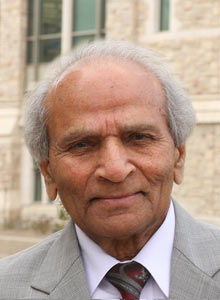
Retirement hasn't slowed Dr. Prasad's work
Researcher awarded with an Earned Doctor of Science Degree for his lifetime of cardiovascular research
By Marg SheridanAnyone who has spent a significant amount of time in the D-Wing of the Health Sciences Building will have, at one point, come across Dr. Kailash Prasad.
A professor emeritus in the Department of Physiology, Prasad can often been seen walking through the halls getting some daytime exercise done on his lunch hour – which is fitting for someone who has spent their life studying cardiovascular diseases.
“I did my MBBS at Darbhanga Medical College in 1957, and then I was going to go into OB/GYN and did an internship in that for six months,” Prasad said when asked why he wanted to focus his work in cardio. “But I realized I couldn’t get sleep because I was on call three days a week, so every time in the middle of the night I’d have to go to the hospital and I thought “this is not my life!” so I thought cardiology would be good.
“There’s no middle-of-the-night ‘I have to go because the baby’s coming’ work.”
Prasad, then earned his M.D. at the University of Delhi in 1961 before moving to Edmonton to complete a PhD in pharmacology at the University of Alberta – which was a move he had intended to be temporary.
“I came to Edmonton to only get a degree and go back, My PhD supervisor was moving to the department of pharmacology at the University of Halifax, and got me a job of assistant professor in the same department, but the Head of the Division of Cardiothoracic Surgery at U of A said "Prasad don't go, you will get the job here.’”
Prasad remained in Edmonton for eight years before landing in Saskatoon in the early 1970’s, where he’d remain for the remainder of his career – and it’s been a long, celebrated career that has spanned from research into the medical usages of flaxseed through to the mechanisms and detection of heart disease.
His research in Edmonton had been centred on studying cardiac cell electrical activity in the human heart, but a lack of resources in Saskatoon upon his arrival meant that Prasad re-entered the patient side of research. His work meant that he was working more closely with heart surgeons to work on studying the mechanisms of heart failure, or coronary heart disease, in the hopes of finding a treatment.
“Then, all of a sudden, I figured I should find out something to detect the heart disease at a much earlier stage,” Prasad explained of the moment he decided on his research project at the U of S. “When the patient gets the chest pain, it’s already too late so I wanted to see if I could develop something that could detect much earlier than even the ECG can detect.”
This would lead Prasad to designing a high-frequency electrocardiogram, in collaboration with an engineer, that registered 15,000 versus the average ECG, which only took 60. It allowed the physician to detect heart disease much earlier – early enough to start some preventative treatment before it worsened.
Since then Prasad has been the lead on quite a few high-profile projects including, research into oxidative stress, coronary artery disease, atherosclerosis, and even research on flaxseed and its components, assisted by chemists at the Agriculture and Agri-Food Canada, for the treatment of atherosclerosis, diabetes, and hypertension.
Prasad had worked at U of S for 24 years until his retirement in 1997 – but he never really left.
“I’ve been working as a retired person for 18 years,” Prasad explained. “I’m interested really, I’m very interested in (research).”
Since his retirement he has published 83 papers, co- edited a Textbook of Angiology, presented 55 talks at various prestigious international scientific congresses, received numerous awards and honours, and received FDA approval of flaxseed components (Beneflax) for health benefits.
At the beginning of June Dr. Prasad was awarded an Earned Doctor of Science Degree for his lifetime of cardiovascular research. He is a Fellow of the Royal College of Physicians of Canada, American College of Cardiology, International College of Angiology and the International Academy of Cardiovascular sciences in addition to holding eight US and Canadian medical patents.
When asked if he had contemplated walking away from his work, of retiring in more than just name, Prasad admitted it had crossed his mind.
“But I’m not sure,” he said. “Even if I leave I’ll be doing something – because I don’t know anything else.”
